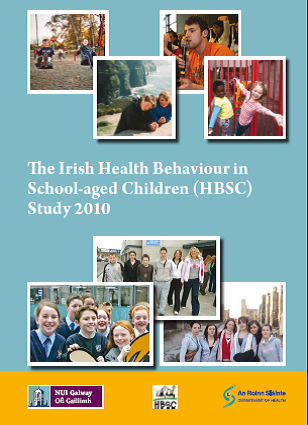Long, Jean
(2012)
Alcohol and cannabis use among school-aged children in Ireland.
Drugnet Ireland,
Issue 42, Summer 2012,
pp. 1-2.
Dr James Reilly TD, Minister for Health, launched the report of the Health Behaviour in School-aged Children (HBSC) survey 20101 on 16 April 2012. Researchers at the National University of Ireland, Galway, did the survey. Previous surveys were conducted in 2006, 2002 and 1998 (www.nuigalway.ie/hbsc).

Overall, 46% of children (aged 10–17) reported that they had consumed an alcoholic drink at some point in their life, a fall of seven percentage points on the 2006 figure of 53%. Girls (43%) were less likely than boys (48%) to report drinking alcohol, and as children grew older they were more likely to report drinking alcohol.
The proportion of children (aged 10–17) who had consumed alcohol in the 30 days prior to the survey was 21%, a fall of five percentage points on the 2006 figure of 26%. Boys (22%) were more likely than girls (19%) to have had alcohol in the last 30 days.
Twenty-eight per cent of children reported having been ‘really drunk’ at some point in their life, a fall of four percentage points on the 2006 figure of 32%. More boys (29%) than girls (26%) reported this, and the proportion reporting drunkenness increased with age: 4% of 10–11-year-olds, 16% of 12–14-year-olds and 52% of 15–17-year-olds. Children from lower social class groups were more likely to report having been ‘really drunk’ than those from middle and higher social class groups. The proportion who reported having been ‘really drunk’ in the 30 days prior to the survey was 18% in 2010 and 20% in 2006, a marginal decrease which may be explained by sampling variation or the sample representation by socio-economic group.
Eleven per cent of 15-year-old girls and 15% of 15-year-old boys had their first episode of drunkenness at the age of 13 years or under.
Eight per cent of children (aged 10–17) reported having used cannabis in the 12 months prior to the survey, a halving of the 2006 figure of 16%. More boys (10%) than girls (6%) reported such use. The proportions increased with age: for example, 1% of 10–11-year-olds compared to 17% of 15–17-year-olds reported such use.
Five per cent of children reported having used cannabis in the 30 days prior to the survey, a fall of two percentage points on the 2006 figure of 7% which may be explained by sampling variation. More boys (7%) than girls (3%) had used cannabis in the month prior to the survey.
The HBSC survey is a cross-national research study conducted in collaboration with the WHO Regional Office for Europe (www.hbsc.org). The survey runs on an academic four-year cycle, and in 2010 there were 43 participating countries and regions. HBSC collects information on the key indicators of health and health-related attitudes and behaviours (including alcohol and cannabis use) among young people aged 11, 13 and 15 years. In Ireland, the HBSC 2010 survey collected data from children aged 9 to 18 years, and the data analysed on alcohol and cannabis is for children aged 10 to 17 years.
A nationally representative sample of primary and post-primary schools in Ireland was randomly selected and subsequently, within schools, classes were randomly selected. The HBSC questionnaire was developed by the international research network and is administered by teachers and completed by the selected students. Younger children receive a shorter questionnaire. Just over two-thirds (67%) of invited schools and 85% of students participated in the survey. Compared to the 2006 survey, the 2010 survey had higher representation from social classes 1 and 2 and lower representation from social classes 3, 4, 5 and 6.
Overall, there was a decrease in self-reported alcohol and cannabis use among school children in Ireland in 2010 when compared to 2006. This may represent a true decrease, possibly owing to children having less pocket money in recent years, or it may be the result of sampling variation, or a combination of both factors. These decreases are welcome, but we must note that at least one in ten 15-year-olds has been drunk by the age of 13, and that more than half our 15–17-year-olds have been drunk at some point in their lives. It is illegal to sell alcohol to children in Ireland, and public health professionals recommend that children should not drink alcohol. This is because the relative immaturity of the adolescent brain compared to that of an adult renders excessive drinking especially hazardous for young people. The American Medical Association reported that an adolescent need drink only half as much as an adult to experience the same negative effects and that even occasional binge drinking can damage the young brain.2 Adolescent drinkers are more likely to perform poorly in school, and to experience social problems.3 In addition, people who begin drinking before the age of 15 are four times more likely to develop alcohol dependence at some time in their lives than those who have their first drink at age 20 or over.4
1. Kelly C, Gavin A, Molcho M and Nic Gabhainn S (2012) The Irish Health Behaviour in School-aged Children study 2010. Dublin and Galway: Department of Health and National University of Ireland. www.drugsandalcohol.ie/17360
3. US Department of Health and Human Services (2007) The Surgeon General's call to action to prevent and reduce underage drinking. Rockville MD: US Department of Health and Human Services, Office of the Surgeon General. www.ncbi.nlm.nih.gov/books/NBK44360
4. Grant BF and Dawson DA (1997) Age at onset of alcohol use and its association with DSM-IV alcohol abuse and dependence: results from the National Longitudinal Alcohol Epidemiologic Survey. Journal of Substance Abuse, 9: 103–110.
